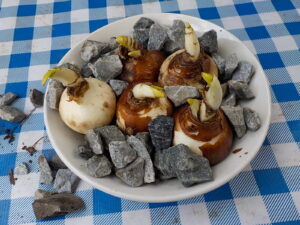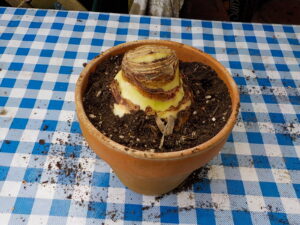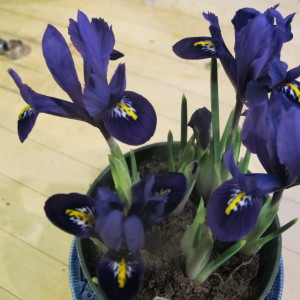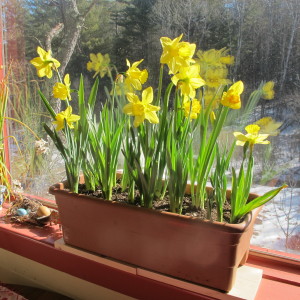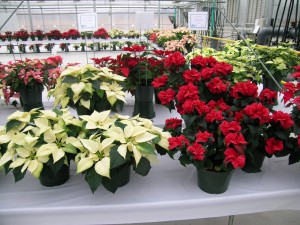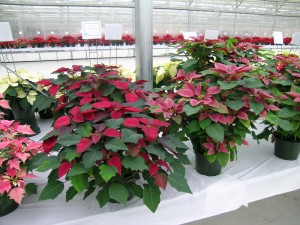Winter Plantings: Paperwhites and Amaryllis
As winter drags along, I long for warm sun and green plants surrounding me outdoors. It’s much too early to start spring seeds (even indoors), but I can plant some flower bulbs. I love paperwhites and amaryllis, and both are readily available for planting now – and they will bloom indoors while it snows outside.
I should warn you that paperwhites have strong scents, and not everyone is enthralled with their smell. But I like the scent, which I can smell once I walk into a room with freshly blooming paperwhites. If you don’t like strong-smelling musky scents, there is one variety that is barely fragrant: ‘Grand Soleil d’Or’. Instead of the traditional white blossoms, these bulbs produce gold or yellow blossoms.
A more expensive – but more dramatic – flower for forcing is amaryllis. This is a tropical flower originally from South Africa – and many are still imported from there each year. Properly cared for, your investment in an amaryllis bulb will produce a plant that will last for up to 75 years, blooming every year!
Potted Bulb Plants
As we amble toward spring I find I crave blossoms more and more. This must delight the people who sell flowers, as I have a hard time walking by a display of iris or daffodils growing in pots without buying some. But buying grocery store potted bulb-flowers is not just an indulgence. Many can be kept alive until the ground thaws and planted. Others are less durable. Let’s take a look.
I love those little purple iris that are commonly sold in 4-inch pots. I bought some recently for $3.99 and although they only lasted a week, I was delighted to have them. This particular iris is known to botanists by its Latin name, Iris reticulata. It’s related to Siberian iris and bearded iris, but has different growing needs.
According to the tag that came with the iris, you can plant these outdoors “in part shade after last spring frost.” What they don’t tell you is that Iris reticulata require very good drainage. They originated in the mountains of western Asia where they grow wild on pumice slopes of extinct volcanoes.
If you want these fabulous little iris to succeed for you, do not plant them in a heavy clay soil. In fact, build a six-inch raised bed of sandy soil and grit with very little organic matter. Outline your planting bed with stones or bricks. You should be able to pour water from your watering can over the bed and not have any pooling. Planting on a hillside will help with drainage, too. Most of my soil is too rich for Iris reticulata, so I’ve not had good luck with them after the first year. I guess this year I’ll build them their own little bed.
Tete-a-tete daffodils are great little bundles of yellow joy that are common in grocery stores and at flower shows. Each bulb produces more than one mini daffodil. They are very cold hardy and can be planted outdoors when the soil has thawed. Just keep them watered indoors after blooming. Like other small bulbs, plant the tips just 2 inches beneath the soil surface.
Every year I force paper whites. Also in the daffodil family, these are not usually planted in soil indoors, but in a container filled with pebbles. Choose one that has no holes and arrange the paper whites bulbs among the stones. Later, when the leaves and stems are tall, they will tip over unless you arrange your stones so that they hold the bulbs in place. I add water until it just kisses the bottom of the bulbs. Roots emerge and soon thereafter green leaves and flower buds emerge. Each bulb should produce more than one blossom.
The paper white flowers are usually – though not always – highly fragrant. Some people do not like the scent, though I do. And even after the flowers have dried out they still look good to me for quite a while. The unfortunate part about paperwhites is that they are not viable in our climate outdoors. No, do not save them and plant outdoors. They will not come back for you next year.
I also potted bulbs for forcing that I put in my cold basement last November, and I have brought them up into the light and warmth of the house. This year I used a plastic container called an “Earth Box” for planting. The one I used is 22 inches long, 9 inches wide and has a planting space about 7 inches deep; I planted about 20 bulbs in it. It is a “self-watering container” that has a water holding compartment a couple of inches deep.
Self-watering containers are all the rage for growing flowers on decks and doorsteps. They prevent the dehydration (and death) that old fashioned flower pots allowed. They wick up water from the water reservoir so that you only have to water once a week or so, depending on the weather. But they are great as containers for bulbs, too, because they don’t leak water out onto your table or windowsill unless you dump gallons of water and make them overflow.
Tulips are some of my favorite flowers but are also loved by deer, chipmunks, voles (but never moles), red squirrels, gray squirrels and a variety of other rodents. The bulbs are even edible by humans – some Dutch ate them to avoid starvation in WWII. So most years I plant some in pots and force them to bloom indoors. Just enjoy them now.
My personal experience is that tulips bloom well their first year –indoors or out – but fewer and fewer bloom each year thereafter. So if you buy potted tulips at the florist shop or nursery, I don’t think they are worth babying along until summer and planting outdoors in May.
I planted 100 tulips in a big raised bed in my vegetable garden last fall. I planted a few garlic cloves in with them in an effort to discourage rodents, though that is no sure cure. In the past deer have not bothered my tulips, but if I am feeling paranoid or see lots of footprints near the tulip bed, I could surround it with a chicken wire fence. Since the bed is only 8 feet by 3 feet, even a 4-foot fence should keep out the deer, I believe. I will use the tulips as cut flowers.
So brighten your house with some flowers grown from bulbs. Most you’ll be able to plant outdoors for another show next year, albeit later.
Henry may be reached by e-mail at henry.homeyer@comcast.net or at P.O. Box 364, Cornish Flat, NH 03746. Please include a stamped envelope if you wish a response by mail.
Poinsettias, Amaryllis and Paperwhites, Oh My!
I love to grow things. In fact, I will try growing almost anything once. Indoors, outdoors, elegant, clunky, thorny – every plant has its virtues. I even accepted (against my better judgment) a Crown of Thorns plant (Euphorbia Milii) from my friend and fellow writer, Willem Lange. It was, I believe, a plant from his grandmother – and Will is older than I am. So it might be a 100-year old house plant. It does have nice small reddish flowers (it blooms constantly), but it is tall and lanky and covered with dangerous thorns. I keep it on the deck in the summer where leaves and pine needles fall on it – but I’m afraid to go into the interior regions of this plant to clean them up now, as I might need a blood transfusion after doing the job.
I recently purchased an amaryllis kit at my favorite general store. Amaryllis plants are wonderful: they will produce anywhere from 3 to 9 lovely large lily-like blossoms. They are foolproof if you follow the directions. They come with a soil-like medium, a pot and the bulb. Just hydrate the disk of planting medium (generally coir, a sustainable alternative to peat moss made of shredded coconut fiber) and plant the amaryllis bulb. Half or more of the bulb should be above the soil line in the pot. I like to soak the roots in warm water for 15 minutes before planting to make them more flexible, though the directions don’t tell you to do that. Put on a sunny windowsill and wait. Sometimes an amaryllis bulb will start growing immediately, other times it will sit and sulk for up to a month. (You might want to talk to it, giving it encouraging words if you’re in a hurry). Sometimes it will produce leaves, then flowers – but most commonly the flowers come first. Sometimes you will get just one stalk of flowers, other times 2 or even 3 in sequence. The more you pay for the bulb, generally, the more stems you will get.
Even easier than amaryllis are poinsettias. Every florist and grocery store has them for sale in full bloom right now, ready to adorn your table. Only the “flowers” are not really flowers. They are modified leaves called bracts, which surround an inconspicuous yellow flower in the middle of each cluster. You can get them in a wide variety of colors and shapes. Red is the classic color, and still my favorite, but they also come in pink, cream, striped, peach, cinnamon and more. The key to happy poinsettias is to avoid overwatering them. Only water when the soil feels dry – and when the pot feels light when you pick it up. They do fine in the interior of the house – they don’t need direct sunlight, which may account, in part, for their popularity. You can save them from year to year but the production of the colorful bracts depends on having days of a certain length, which is best done in a greenhouse. And contrary to popular myth, the plants are not poisonous to cats – a University of Ohio team tested them. Poor test kitties, I’m sure they’re not tasty. (I do wonder how they got the cats to eat the poinsettias).
Paperwhite are another sure winner for the holidays, and a great gift for the gardener. These are generally sold as bulbs, not kits, so you have a little more work to do if you’d like these fragrant white blossoms. And it’s too late to get them blooming by Christmas. They generally take a month or more from planting to blooming (for me, anyway). But I shall buy some today, and get started. Paperwhites are in the narcissus or daffodil family. To get them to bloom you will need a flat, wide dish that is an inch or two deep. Fill the dish with gravel or small stones. And although you can pick stones out of your driveway, white stones are available at garden centers in small bags and look much nicer. Simply arrange the bulbs shoulder-to shoulder in the gravel with at least half the bulb sticking up above the layer stones. Then add water until it just kisses the bottom of the bulbs. Do not, I repeat, do not fill the dish with too much water, as you can rot the bulbs. You may need to tie up your paperwhites to keep them from flopping over when the leaves and flower stems get tall. And rotating the dish every few days keeps them from leaning toward the window grasping for more winter light. Paperwhites produce more than one blossom on each stem, and are really quite elegant. They are not re-useable, however. That’s right. After they bloom just throw them away because they are not hardy in New England.
Winter in New England can be bleak. I buy cut flowers at my local florist to keep on the table to brighten the room and remind me of summer. But a few good plants can tide me over during those times when the flowers I’ve bought have gone by, and before I get the next batch. And as to that Crown of Thorns, writing this column inspired me to work on cleaning it up. I used the vacuum cleaner and it worked!
Visit www.henry.homeyer.com to read about Henry’s new children’s book, Wobar and the Quest for the Magic Calumet. It is a fantasy-adventure chapter book about a boy and a cougar.



